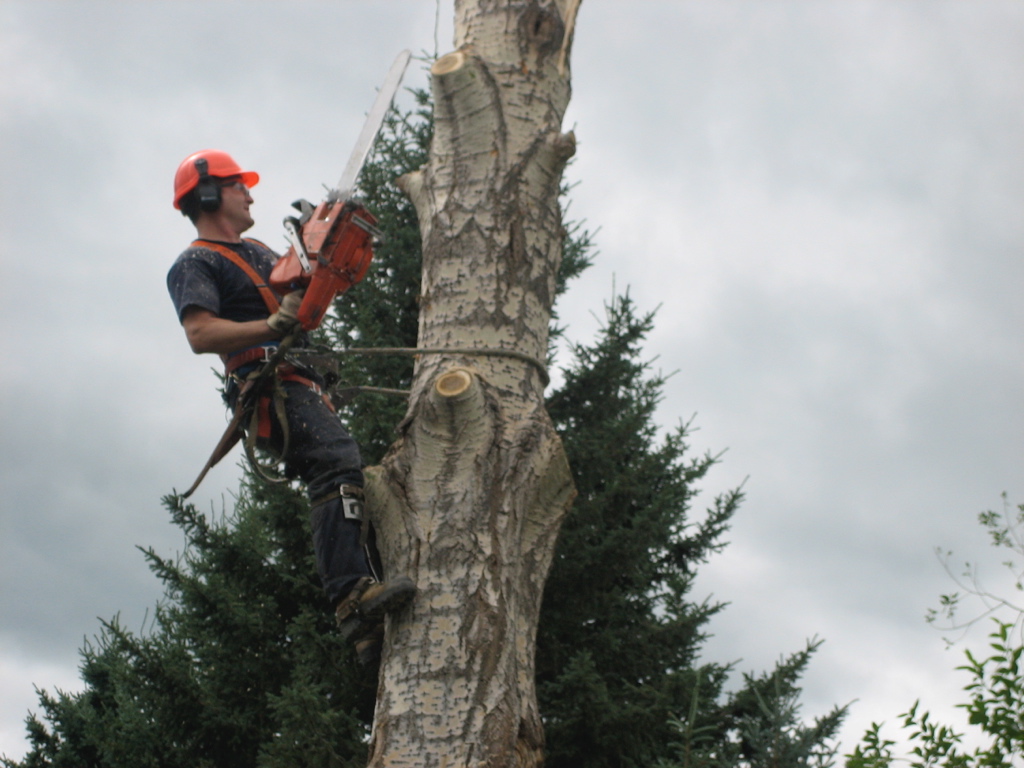 Our Tree Services & Resources
Our Tree Services & Resources
Here you can find additional resources considering tree care and hiring an arborist. If you have any questions about aerial tree services resources or would like to request a free estimate, contact Aerial Tree Services Ltd. in Calgary.
Why Hire an Arborist
Pruning
With an arborist, you can determine what kind of pruning is required to help maintain or improve your trees’ health, safety, and appearance. Pruning can help:
- Keep branches from rubbing up against one another
- Remove limbs that may touch wires, buildings, gutters, roofs, and more
- Obstruct streets or sidewalks
- Eliminate the dead or weak limbs that could be hazardous
- Remove insect-infected or diseased limbs
- Create a stronger structure that lessens wind resistance, reducing damage during storms
- Train young trees to grow into proper positions
- Get rid of weather damaged limbs
- Thin or removal unnecessary branches
- Improve the shape or silhouette of the tree
Removal
Tree removal should be considered a last resort, but certain circumstances make it necessary. With a certified arborist like Aerial Tree Services Ltd., we can help you decide whether or not your tree should be removed. We have the skill and equipment to safely and efficiently remove unwanted or hazardous trees.
Some circumstances that could require tree removal:
- Dead or dying tree
- Obstruction by a tree that can’t possibly be corrected with pruning
- Tree crowds or causes harm to other trees
- Need to replace old tree with more suitable specimen
- Tree has to be removed for new construction
Emergency Tree Care
After a severe storm, tree limbs or an entire tree may fall, often landing on homes, cars, other trees, or various structures. This is a situation that calls for emergency tree care. The weight of storm-damaged trees is great and requires an expert to remove or trim them. An arborist can assist in performing this job in a careful manner, keeping your property from further risk of damage.
Planting
Planting the wrong tree in the wrong location can lead to future problems due to limited growth space, insects, or diseases. Not sure what kind of tree works best for your property? An arborist can help with that by offering recommendations on the types of trees appropriate for your specific location. Some arborist can even offer planting services.
Other Aerial Tree Services Resources
Other tree care services arborists can provide include:
- Preventative maintenance against insects, diseases, and more
- Fertilization
- Support to weak branches with cabling or bracing
- Aeration to improve root growth
- Installation of lightning protection systems
- Insect and disease control
Why Not to Top Trees
Aerial Tree Services Resources
Why Topping Hurts Trees
Topping is the indiscriminate cutting back of tree branches to stubs or lateral branches that are not large enough to assume the terminal role. Other names for topping include “heading,” “hat-racking,” and “rounding over.”
The most common reason given for topping is to reduce the size of a tree. Often homeowners feel that their trees have become too large for their property. People fear that tall tress may pose a hazard. Topping, however, is not a viable method of height reduction and certainly does not reduce the hazard. In fact, topping will make a tree more hazardous in the long term.
Topping Causes Decay
The preferred location to make a pruning cut is just beyond the branch collar at the branch’s point of attachment. The tree is biologically equipped to close such a wound provided the wound is not too large. Cuts made along a limb, between lateral branches, create stubs with wounds that the tree may not be able to close. The exposed wood tissues begin to decay. Normally a tree will “wall off” or compartmentalize the decaying tissues. But few trees can defend the multiple severe wounds caused by topping. The decay organisms are given a free path to move down through the branches.
Topping Can Lead to Sunburn
Branches within a tree’s crown produce thousands of leaves to absorb sunlight. When the leaves are removed, the remaining branches and trunk are suddenly exposed to high levels of light and heat. The result may be sunburn of the tissues beneath the bark. This can lead to cankers, bark splitting, and death of some branches.
Topping Creates Hazards
The survival mechanism that causes a tree to produce multiple shoots below each topping cut comes at great expense to the tree. These shoots develop from buds near the surface of the old branches. Unlike normal branches that develop in a “socket” of overlapping wood tissues, these new shoots are only anchored in the outermost layers of the parent branches.
The new shoots grow very quickly, as much as 20 feet in one year, in some species. Unfortunately, the shoots are very prone to breaking, especially during windy conditions. The irony is that while the goal was to reduce the tree’s height to make it safer, it has been made more hazardous than before.
Topping Makes Trees Ugly
The natural branching structure of a tree is a biological wonder. Trees form a variety of shapes and growth habits, all with the same goal of presenting their leaves to the sun. Topping removes the ends of the branches, often leaving ugly stubs. Topping destroys the natural form of a tree.
Without the leaves (up to six months of the year in temperature climates) a topped tree appears disfigured and mutilated. With the leaves, it is a dense ball of foliage, lacking its simple grace. A tree that has been topped can never fully regain its natural form.
Hidden Costs of Topping
The cost of topping a tree is not limited to what is initially paid. If the tree survives, it will require pruning again within a few years. It will either need to be reduced again, or storm damage will have to be cleaned up. If the tree dies it will have be removed. Topping is a high maintenance pruning practice.
There are some hidden costs of topping. One is the reduction in property value. Healthy, well maintained trees can add 10 – 20% to the value of the property. Disfigured, topped trees are considered an impending expense.
Another potential cost of topped trees is the potential liability. Topped trees are prone to breaking and can be hazardous. Since topping is considered to be an unacceptable pruning practice, any damage caused by branch failure of a topped tree may lead to a finding of negligence in a court of law.
Alternatives to Topping
There are times when a tree must be reduced in height or spread. Providing clearance for utility lines is as example. There are recommended techniques for doing this. If practical, branches should be removed back to their point of origin. If a branch must be shortened, it should be cut back to a lateral that is large enough to assume the terminal role. A rule of thumb for this is to cut back to a lateral that is at least 1/3 the diameter of the limb being removed.
This method of branch reduction helps to preserve the natural form of the tree. However, if large cuts are involved, the tree may not be able to close over and compartmentalize the wounds. Sometimes the best solution is to remove the tree and replace it with a species that is more appropriate for the site.
Developed by the International Society of Arboriculture (ISA), a non-profit organization supporting tree care research around the world and dedicated to the care and preservation of shade and ornamental trees. For further information, contact: ISA, P.O. Box 3129, Champaign, IL. 61826-3129, USA
@1995 International Society of Arboriculture.
Aerial Tree Services Resources
The City of Calgary – Tree Pests & Diseases
ISA Trees Are Good®
Alberta One Call (Click Before You Dig)
Arborist Supply Co.
Blue Grass Nursery
Olds College
Calgary Urban Forest Management Map
